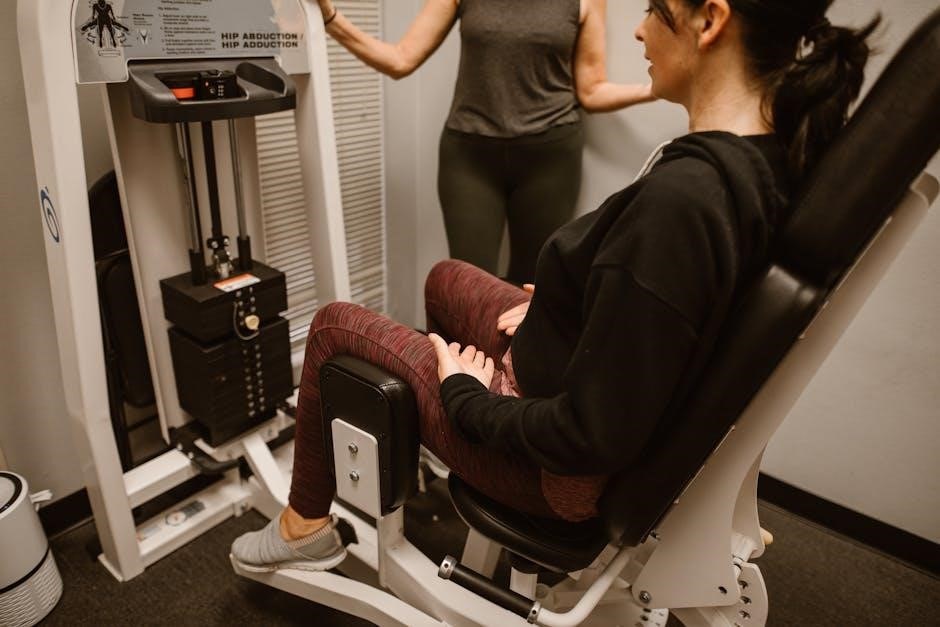Polycystic Ovary Syndrome (PCOS) is a common hormonal disorder affecting women of reproductive age. Exercise plays a crucial role in managing PCOS symptoms, improving insulin sensitivity, and promoting hormonal balance. Regular physical activity helps reduce weight, enhances fertility, and boosts overall well-being for women with PCOS.
Understanding PCOS
Polycystic Ovary Syndrome (PCOS) is a hormonal disorder affecting 1 in 10 women, causing irregular periods, weight gain, and insulin resistance. It impacts fertility, metabolism, and overall health. Understanding PCOS is crucial for managing symptoms and improving quality of life through lifestyle changes and targeted interventions.
Role of Exercise in Managing PCOS
Exercise is a cornerstone in managing PCOS, improving insulin sensitivity, aiding weight management, and promoting hormonal balance. Regular physical activity enhances metabolism, reduces insulin resistance, and boosts fertility. A well-rounded routine combining cardio, strength training, and flexibility helps alleviate symptoms and improves overall health for women with PCOS.

Benefits of Exercise for PCOS
Exercise improves insulin sensitivity, aids in weight management, and enhances hormonal balance, reducing PCOS symptoms. It boosts metabolism, improves fertility, and increases overall well-being for women with PCOS.
Improving Insulin Sensitivity
Exercise enhances insulin sensitivity by promoting glucose uptake in cells, reducing insulin resistance; Aerobic and strength training improve glycemic control, benefiting women with PCOS by lowering blood sugar levels and improving hormonal function. Regular physical activity helps regulate insulin levels, reducing the risk of type 2 diabetes and metabolic complications associated with PCOS.
Weight Management
Regular exercise is crucial for weight management in PCOS. A balanced workout plan combining cardio, strength training, and flexibility helps burn calories and maintain muscle mass, essential for metabolism. Even moderate weight loss can improve PCOS symptoms. Consistency is key to achieving and maintaining a healthy weight, promoting long-term well-being.
Hormonal Balance
Exercise plays a vital role in restoring hormonal balance for women with PCOS. Activities like strength training and cardio help lower androgen levels and improve insulin sensitivity, which can regulate menstrual cycles and reduce symptoms. Consistent physical activity supports endocrine function, promoting overall hormonal equilibrium and enhancing quality of life.

Types of Exercises for PCOS
A well-rounded workout plan for PCOS includes cardiovascular exercises, strength training, and flexibility routines. These activities improve insulin sensitivity, hormonal balance, and overall well-being effectively.
Cardiovascular Exercises
Cardiovascular exercises, such as brisk walking, jogging, cycling, or swimming, are essential for improving insulin sensitivity and aiding in weight management. They enhance blood flow, boost energy levels, and support hormonal balance. Consistency is key to seeing positive results, making cardio a cornerstone of any effective PCOS workout plan.
Strength Training
Strength training is vital for women with PCOS, as it builds muscle mass, boosts metabolism, and improves insulin sensitivity. Incorporate weights, resistance bands, or bodyweight exercises like squats and lunges. Aim for 2-3 sessions weekly to enhance hormonal balance and support long-term weight management, tailored to your fitness level and goals.
Flexibility and Stretching
Flexibility and stretching exercises are essential for improving circulation, reducing muscle tension, and enhancing overall mobility. Activities like yoga and Pilates can help manage stress and improve posture. Incorporate stretching routines 2-3 times a week, focusing on major muscle groups. This complements strength training and supports recovery, promoting a balanced workout regimen for PCOS management.
Creating a Personalized Workout Plan
Set realistic goals, choose enjoyable activities, and schedule workouts consistently. Tailor routines to fit your lifestyle, ensuring a mix of cardio, strength, and flexibility exercises for sustainable progress.
Setting Realistic Goals
Set specific, measurable, and achievable goals to stay motivated. Start with short-term targets, like exercising 30 minutes three times a week, and gradually increase intensity. Celebrate milestones to maintain progress and adjust goals as needed. Ensure your objectives align with your fitness level and health aspirations for sustainable success.
Choosing Enjoyable Activities
Select activities you enjoy, such as yoga, swimming, or cycling, to make your workout routine sustainable. Incorporate strength training and Pilates to improve hormonal balance and metabolism. Group classes or home workouts can add variety and keep you motivated, ensuring long-term adherence to your PCOS workout plan.
Scheduling Workouts
Create a fitness plan with specific workout times to ensure consistency. Balance strength training, cardio, and flexibility exercises throughout the week. For example, schedule 3 days of strength training, 2 days of cardio or Pilates, and 2 rest days. Start with manageable time frames and gradually increase as your fitness level improves.
Nutrition and Hydration for PCOS Workouts
Proper nutrition and hydration are vital for PCOS workouts. Consume a balanced meal with carbs, proteins, and healthy fats before exercising. Stay hydrated throughout and include chia seeds for optimal energy.
Pre-Workout Meals
A balanced pre-workout meal is essential for energy and performance. Include complex carbs, lean proteins, and healthy fats, such as whole grain toast with avocado or nuts. Avoid heavy meals and opt for light, digestible snacks like fruit or yogurt. Aim to eat 60-90 minutes before exercise to maintain stamina and hydration levels.
Hydration Tips
Stay hydrated by drinking water 30 minutes before exercise and sip 1-2 mouthfuls during workouts. Avoid sugary drinks and opt for electrolyte-rich beverages. Post-workout, rehydrate fully to replenish lost fluids. Incorporate water-rich foods like cucumbers or oranges. Aim for 8-10 glasses of water daily to support metabolism and energy levels during PCOS workouts.
Post-Workout Recovery
After exercise, refuel with a balanced meal containing protein, healthy fats, and complex carbs to stabilize blood sugar. Incorporate gentle stretching or yoga to relax muscles and improve flexibility. Prioritize rest to allow your body to repair and recharge, essential for managing PCOS symptoms and maintaining energy levels.
Sticking to Your Workout Routine
Consistency is key to seeing results. Track progress, celebrate small victories, and stay motivated by reminding yourself of your goals. Make exercise a non-negotiable part of your daily routine for long-term success;
Building Consistency
Consistency is achieved by creating a realistic routine that fits your lifestyle. Schedule workouts at the same time daily and track progress to stay accountable. Celebrate small milestones to stay motivated and remind yourself of long-term goals. Consistency breeds habits, and habits lead to sustainable results in managing PCOS symptoms effectively.
Overcoming Challenges
Start with manageable routines and gradually increase intensity to avoid burnout. Prioritize hydration and nutrition, incorporating chia seeds for energy. Address physical discomfort by modifying exercises. Stay motivated by celebrating small achievements and setting realistic milestones. Building resilience helps maintain long-term commitment to your PCOS workout plan and overall well-being.
Tracking Progress

Regularly monitor your workouts, weight, and measurements to assess improvements. Use a fitness journal or app to log activities and achievements. Celebrate small milestones to stay motivated. Track changes in energy levels, mood, and physical health to ensure your PCOS workout plan is effective and tailored to your needs over time.

Mental Health and Exercise
Exercise improves mental health by reducing stress, boosting mood, and enhancing self-esteem. Regular activity releases endorphins, combating anxiety and depression often linked to PCOS, promoting emotional well-being.
Reducing Stress
Exercise is a powerful tool for reducing stress and anxiety, common in PCOS. Physical activity releases endorphins, natural mood lifters, helping alleviate emotional distress. Regular workouts provide mental distraction, improve focus, and promote relaxation, aiding in stress management and overall emotional well-being for women with PCOS. Consistency is key for long-term benefits.
Improving Mood
Exercise significantly enhances mood by releasing endorphins, which act as natural antidepressants. Physical activity reduces anxiety and depression, common in PCOS, by promoting a sense of accomplishment and well-being. Activities like brisk walking, swimming, or strength training can elevate mood, helping women with PCOS maintain emotional balance and a positive outlook.
Building Confidence
Exercise empowers women with PCOS by fostering physical achievements and a positive body image. Regular workouts help celebrate small victories, enhancing self-esteem and confidence. Strength training and consistent activity promote a sense of accomplishment, encouraging women to embrace their bodies and feel more confident in their daily lives and long-term health journey.
Sample 7-Day Workout Plan
A well-rounded 7-day plan includes strength training (Days 1-3), cardio and Pilates (Days 4-5), and rest or low-intensity activities (Days 6-7) to promote balance and recovery.
Day 1-3: Strength Training
Focus on compound movements like squats, lunges, and deadlifts to build muscle and boost metabolism. Include exercises targeting the upper body, such as push-ups, rows, and shoulder presses. Use dumbbells, resistance bands, or bodyweight for resistance. Aim for 3 sets of 8-12 reps per exercise. Incorporate core and pelvic floor exercises to enhance stability and strength.
Day 4-5: Cardio and Pilates
Engage in moderate-intensity cardio like cycling, swimming, or brisk walking for 30-40 minutes. Follow with Pilates exercises focusing on core strength, pelvic floor engagement, and flexibility. Include movements like planks, bridges, and leg raises. Modify intensity based on fitness levels to ensure safety and effectiveness for women with PCOS.
Day 6-7: Rest and Recovery
Rest days are crucial for allowing your body to heal and recharge. Engage in light activities like yoga or stretching to maintain flexibility and relaxation. Focus on proper nutrition, hydration, and sleep to aid muscle recovery. Use this time to practice stress-reducing techniques like meditation. Prioritize listening to your body to avoid overexertion.
Consistency is key to long-term success. Tailor your workouts to your lifestyle and gradually adjust as your fitness level improves. Celebrate small victories and maintain a balanced approach for sustainable health.
Reviewing Progress
Regularly track your progress to stay motivated and ensure your workout plan is effective. Set measurable goals, like increased strength or improved endurance, and celebrate achievements. Adjust your routine as needed to avoid plateaus and maintain momentum. Monitoring progress helps refine your strategy and keeps you committed to long-term health goals.
Adjusting the Plan
As you progress, tailor your workout plan to suit your evolving needs and goals. Incorporate new exercises or increase intensity to avoid plateaus. Regularly assess what works and make adjustments to keep your routine effective and engaging. Flexibility in your plan ensures long-term success and adapts to your changing fitness level.
Maintaining Long-Term Health
Sustaining a healthy lifestyle is key for women with PCOS. Consistency in exercise and nutrition helps manage symptoms and prevents future health issues. Focus on balanced habits, stress reduction, and adequate sleep to support overall well-being. Regular check-ups and adjustments to your plan ensure continued progress and long-term health benefits for PCOS management.